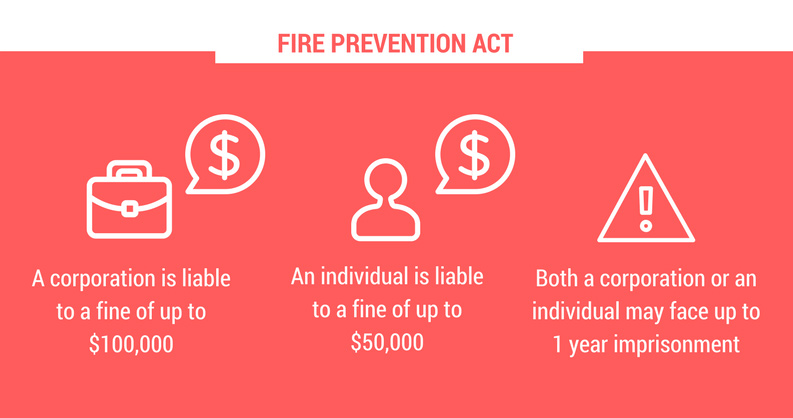Is Your Fire Watch Program Up To Code?
What is a Fire Watch?
In Canada and the US, there are regulations such as the the National Fire Protection Association (NFPA) and jurisdictional Fire Codes that require buildings equipped with fire alarm systems and sprinkler systems to be fully operational at all times. In the event that any of these systems are off-line for any reason whatsoever, or there is the presence of Hot Works being performed, a Fire Watch inspection program is to be implemented immediately.A Fire Watch inspection program is the regular, physical inspection of the area to ensure a fire does not start. This inspection should be completed once every hour. A Fire Watch inspection program needs to be implemented if there are life safety systems that are offline and/or there is Hot Works being performed.
Hot Works
Did you know?
Hot Works is defined as any process involving flame, spark or heat production. This includes work such as cutting, welding, soldering, grinding etc.
- The Fire Watch work area must be inspected at least once each hour
- The Fire Watch personnel must be equipped with a fire extinguisher and PPE
- The Fire Watch must be conducted from the start of the Hot Works until at least 3 hours after the work has been completed
A Hot Works Fire Watch team must consist of three trained individuals, all of whom have the responsibility and authority to stop the hot work if the situation becomes unsafe:
- The permit authorizing individual – a member of the Management team.
- The hot work operator – professionally trained for the job.
- The Fire Watch – this individual conducts regular inspections of the area and job, and is generally a member of the security team.
According to the NFPA, from 2014-2018 fire departments in the United States responded to an estimated average of 4,580 structure fires per year involving equipment associated with hot work.
These fires caused an annual average of:
- 22 civilian deaths
- 171 civilian injuries
- $484 million in property damage
- Over 300+ Toronto building owners were charged with fire code violations in 2016.
- Fire code fines totaling $1,550,297 were imposed on Toronto building owners in 2015.
- Fire code fines totaling $1,464,929 were imposed on Toronto building owners in 2014.
At minimum, failing to provide Fire Watch documentation of inspections can result in multiple offences and fines ranging from $195-$295 each.
If it is deemed by the authorities that the Fire Prevention Act has been violated, the following penalties can be incurred:
- A corporation is liable to a fine of up to $100,000
- An individual is liable to a fine of up to $50,000 and/or
- Members of both a corporation or an individual may face up to 1 year imprisonment
One effective solution to reduce risk is digitizing Fire Watch inspections. Using a digital solution that utilizes technology, such as near-field communication instead of pen and paper, will ensure that the area under Fire Watch is inspected hourly and will expedite the remainder of the inspection process for the facility's team. Solutions that can alert if a Fire Watch inspection is about to be missed or is overdue is an easy way to stay on track.
Digital solutions also help ensure that the inspection took place as the inspector needs to visit the area in order to complete the inspection, reducing instances of false reporting that can happen with pen and paper. They can also help forecast where resources are needed through the ability to see analytics and trends.
For example, a few years ago, one of the large hospitals in Toronto decided to implement a digital solution to manage their hourly Fire Watch inspections on a construction floor that experienced a significant flood. After implementing the digital solution, they quickly realized that they had to shift their resource allocation in order to meet the hourly checks - this is something that likely fell through the cracks with pen and paper inspections. After implementing the digital inspection solution, the facility team was able to adequately comply with inspection requirements of their Fire Watch program.
Additionally, digital inspection solutions can provide on-the-spot guidance, checklists and training for staff; staff can include photos and notes with their inspections and they provide easily accessible, organized and exportable reports which are especially important if someone needs to see evidence of your Fire Watch program.
The stakes are too high. Don’t assume your Fire Watch is being completed. Digital options are available to ensure that the Hot Works area and/or the area with offline life safety systems are being inspected at least once every hour as required by law.
For more information, or for a consultation on Fire Watch, please contact info@tapreport.io.
Resources
[i] Section 5.11.2.5 of the Ontario Fire Code https://www.ontario.ca/laws/regulation/070213
[ii] Ahrens, Mary. NFPA Structure Fires Started by Hot Work, Sept 2016. https://www.nfpa.org/News-and-Research/Data-research-and-tools/US-Fire-Problem/Structure-Fires-Started-by-Hot-Work
[iii] Rider, David. The Star. Landlord fined $71,000 after fatal Jane St. apartment fire. July 18, 2016. https://www.thestar.com/news/gta/2016/07/18/landlord-fined-71000-after-fatal-jane-st-apartment-fire.html
[iv] Regulation 213/07 under the Fire Protection and Prevention Act, 1997. http://www.ontariocourts.ca/ocj/how-do-i/set-fines/set-fines-i/schedule-17-4/
[v] Statute Laws https://www.ontario.ca/laws/statute/97f04



